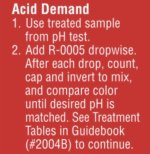- Sep 23, 2015
- 2,012
- Pool Size
- 20000
- Surface
- Plaster
- Chlorine
- Salt Water Generator
- SWG Type
- Astral Viron V25
Another trick to seeing change in the phenol red pH colors is to use the acid and base demand reagents dropwise and see the color change.
Just like anything, you have to take care of it to work correctly.There are plenty of threads discussing electronic meters, mostly handhelds. Electronic testers need calibration to two points and storage in a potassium chloride solution both of which costs money and takes time and even then the results can be skeptical. Old meters, poor calibration, cheep calibration fluids, incorrect storage, old probe, old batteries, etc. will all lead to poor results. People often confuse extra decimal places with accuracy. Without calibration an electronic meter is nothing more then a random number generator. And at the same time 4-5 drops in a pH comparator is more than accurate enough for most users.
You have intrigued me with this comment. Could I trouble you to elaborate or point me to where I might learn how to do this?Another trick to seeing change in the phenol red pH colors is to use the acid and base demand reagents dropwise and see the color change.
And that is their achilles heel. The average person has no idea how to how to use one correctly or take care of it. They just don’t know that their $30 meter requires $100+ in calibration and storage solutions. They buy a cheepy off the net, don’t calibrate it, don’t rinse it, and probably just leave it out in the weather at their equipment pad and because it’s still giving a readout to two decimal places they think it’s working fine. Even if the instructions include directions for the proper care and use most wouldn’t read it.Just like anything, you have to take care of it to work correctly.
You have intrigued me with this comment. Could I trouble you to elaborate or point me to where I might learn how to do this?

Hi Steve, Your effort was not for naught. I now understand that you were referring to the residual chlorine test. I’ve used that test in the past with my previous test kits, though I routinely skip it in my water testing. It had slipped my mind, so I didn’t recognize it with your initial comment. I now see how it might be used to more precisely determine the sample pH. Thank you for clarifying.


